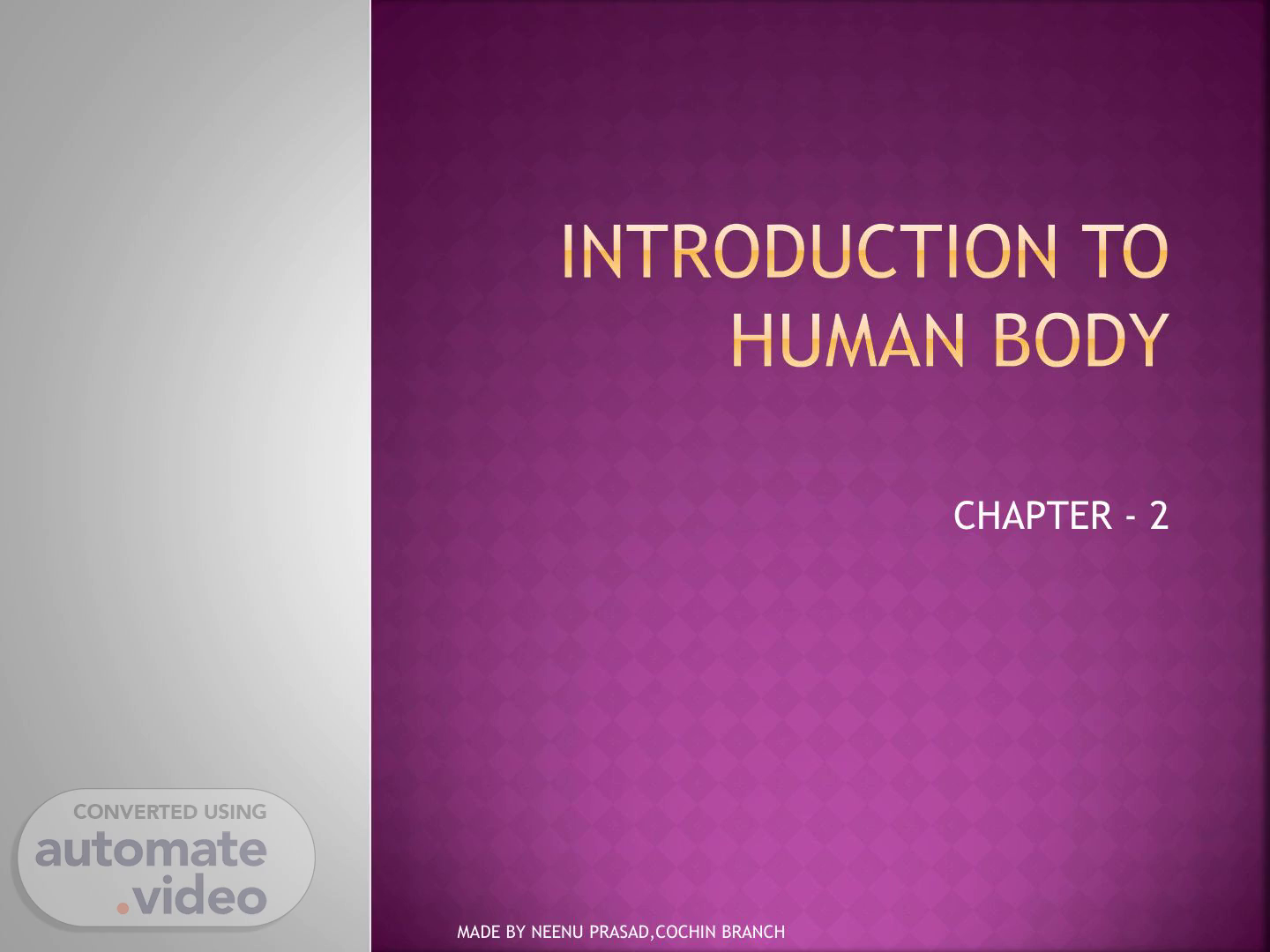
INTRODUCTION TO HUMAN BODY
Scene 1 (0s)
CHAPTER - 2 MADE BY NEENU PRASAD,COCHIN BRANCH.
Scene 2 (6s)
Anatomy: Study of structure of organism Physiology: Study of functions and activities of organism MADE BY NEENU PRASAD,COCHIN BRANCH.
Scene 3 (16s)
Growth Hyperplasia=increase in number Hypertrophy=increase in size Metabolism Catabolism=dissimilation=destruction phase, energy is released eg.glycolysis Anabolism=assimilation =construction phase=biosynthesis, uses energy eg.protein synthesis Movement Respiration (inspiration &expiration) MADE BY NEENU PRASAD,COCHIN BRANCH.
Scene 4 (29s)
Digestion Reproduction Excretion(faeces, sweat, urine, CO2) Responsiveness Differentiation Organization MADE BY NEENU PRASAD,COCHIN BRANCH.
Scene 5 (38s)
MADE BY NEENU PRASAD,COCHIN BRANCH.
Scene 6 (45s)
It is the basic unit of life or body Study of cells is called cytology Longest cells and the cells that cannot regenerate in the human body are the nerve cell Largest cell is ovum Smallest cell is sperm MADE BY NEENU PRASAD,COCHIN BRANCH.
Scene 7 (59s)
MADE BY NEENU PRASAD,COCHIN BRANCH.
Scene 8 (1m 6s)
The outer covering of the cell is called cell membrane The watery substance present inside the cell in which all the organelles are embeded is called cytoplasm Organelle are the structures found inside the cell in the cytoplasm Largest organelle-nucleus Endoplasmic reticulum-protein synthesis Mitochondria-known as powerhouse of cell due to ATP(energy)production Lysosomes known as suicidal bags because they collect bacteria and virus ,kill them and accumulate in it MADE BY NEENU PRASAD,COCHIN BRANCH.
Scene 9 (1m 27s)
A group of similar cells working together to do a specific job is tissue. Study of the tissues is called histology There are four types of tissues in our body Epithelial - found in skin and innermost lining of hollow organ Connective - (fluid-blood &lymph)(dense bone and cartilage) Nervous Muscular MADE BY NEENU PRASAD,COCHIN BRANCH.
Scene 10 (1m 44s)
MADE BY NEENU PRASAD,COCHIN BRANCH.
Scene 11 (1m 50s)
Fluid –blood and lymph Dense-bone and cartilage MADE BY NEENU PRASAD,COCHIN BRANCH.
Scene 12 (1m 58s)
NERVOUS TISSUE MUSCULAR TISSUE MADE BY NEENU PRASAD,COCHIN BRANCH.
Scene 13 (2m 5s)
Different types of tissues combine to form an organ MADE BY NEENU PRASAD,COCHIN BRANCH.
Scene 14 (2m 14s)
MADE BY NEENU PRASAD,COCHIN BRANCH.
Scene 15 (2m 21s)
INTEGUMENTARY SYSTEM SKELETAL SYSTEM MUSCULAR SYSTEM HEMATOLOGY LYMPHATIC SYSTEM CARDIOVASCULAR SYSTEM RESPIRATORY SYSTEM DIGESTIVE SYSTEM URINARY SYSTEM REPRODUCTIVE SYSTEM ENDOCRINE SYSTEM SENSORY SYSTEM NERVOUS SYSTEM MADE BY NEENU PRASAD,COCHIN BRANCH.
Scene 16 (2m 30s)
MADE BY NEENU PRASAD,COCHIN BRANCH.
Scene 17 (2m 36s)
Frontal/coronal: we get a front i.e.,anterior view and a back i.e., posterior view MADE BY NEENU PRASAD,COCHIN BRANCH.
Scene 18 (2m 48s)
Sagittal/medial/lateral Mid sagittal, we get exactly equal halves of the body into right and left.Parasagittal which means near to sagittal which gives unequal left and right plane. MADE BY NEENU PRASAD,COCHIN BRANCH.
Scene 19 (3m 1s)
MADE BY NEENU PRASAD,COCHIN BRANCH.
Scene 20 (3m 8s)
Cross sectional/Transverse/Horizontal/AxialWe get a Superior which is upper half of the body and Inferior which is lower half of the body MADE BY NEENU PRASAD,COCHIN BRANCH.
Scene 21 (3m 20s)
Anterior situated before, at the front of Posterior situated behind,at the back of Medial pertaining to middle, near to middle of body Lateral far from centre of body part away from middle Superficial on the surface, shallow Deep away from surface, further into the body Superior/cranial/cephalic above over top of Inferior Caudal, podalic, towards the feet Proximal towards the beginning, the nearer of two items Distal more distant far from the origin MADE BY NEENU PRASAD,COCHIN BRANCH.
Scene 22 (3m 40s)
Inversion to turn inward, to turn upside down or inside out, to reverse in position or order Eversion to turn outward Ipsilateral on the same side Contralateral pertaining to the other side Supine with back/dorsal side downward Prone with the front surface downward, lying face downward Dorsal relating to back or posterior Ventral relating to front or anterior MADE BY NEENU PRASAD,COCHIN BRANCH.
Scene 23 (3m 57s)
MADE BY NEENU PRASAD,COCHIN BRANCH.
Scene 24 (4m 4s)
In a child the vertebral formula is as follows: C7T12L5S5C4 In adults some of them get fused and the formula changes to: C7T12L5S1C1 MADE BY NEENU PRASAD,COCHIN BRANCH.
Scene 25 (4m 15s)
A body cavity is a space within the body that contains internal organs ie. Viscera. Many organs are placed inside these cavities The thoracic and abdominopelvic cavity is divided by the respiratory muscle called diaphragm.(phrenico) MADE BY NEENU PRASAD,COCHIN BRANCH.
Scene 26 (4m 30s)
MADE BY NEENU PRASAD,COCHIN BRANCH.
Scene 27 (4m 36s)
MADE BY NEENU PRASAD,COCHIN BRANCH.
Scene 28 (4m 42s)
Cranial cavity Brain Pituitary gland Vertebral cavity Spinal chord Thoracic cavity Lungs Thymus Heart(mediastinal cavity) Abdomininal cavity Stomach Liver Pancreas Gall bladder Spleen Large intestine Small intestine Pelvic cavity Urinary system Reproductive system MADE BY NEENU PRASAD,COCHIN BRANCH.
Scene 29 (4m 51s)
MADE BY NEENU PRASAD,COCHIN BRANCH.
Scene 30 (4m 58s)
MADE BY NEENU PRASAD,COCHIN BRANCH.
Scene 31 (5m 3s)
MADE BY NEENU PRASAD,COCHIN BRANCH.
Scene 32 (5m 8s)
MADE BY NEENU PRASAD,COCHIN BRANCH.